A new idea is taking hold among House Republicans that perhaps breaching the debt ceiling isn’t such a terrible idea after all. One form this takes is the patently absurd remarks of Rep. Ted Yoho (R-Fla.) who muses that “I think, personally, it would bring stability to the world markets.” If you think that’s right, you might wonder why the Chinese government is warning that “the clock is ticking” and politicians need to stop screwing around.
The more sophisticated view comes from the likes of Rep. Justin Amash (R-Mich.) who’s concocted an idea about how we could avoid default even while breaching the debt ceiling:
“There’s always revenue coming into the Treasury, certainly enough revenue to pay interest,” said Rep. Justin Amash, R-Mich. “Democrats have a different definition of ‘default’ than what we understand it to be. What I hear from them is, ‘If you’re not paying everything on time that’s a default.’ And that’s not the traditionally understood definition.”
This is what’s known among debt ceiling junkies as “payment prioritization”—you use cash on hand to keep paying interest and rolling over the principal on the national debt, while letting Medicare reimbursements or salaries for FBI agents slide. Here are four problems with the idea, according to the Treasury Department:
1. It’s illegal: Treasury is not authorized to unilaterally decide to pay certain bills and not others. If it were, the constitutional order would completely collapse. Obama could just not cut the checks for farm subsidies or missile defense programs he opposes. Then in a few years President Ted Cruz could refuse to pay SNAP benefits.
2. It’s also impossible: Because payment prioritization is illegal, Treasury’s payment system is not designed to allow prioritization to happen. Cardiff Garcia has an in-depth roundup of coverage of this angle, but the best simple explanation comes from the Treasury inspector general, who explains that on a technical level, the systems “are designed to make each payment in the order it comes due.” Of course systems could always be changed. But look at all the problems Health and Human Services is having in getting the Affordable Care Act computer systems to work. They can’t just whip up an entirely new computer system in the next two weeks. (And, of course, given the government shutdown, it would be illegal for them to hire someone to try.)
3. The timing doesn’t work: Over a given year, the Treasury certainly collects more in taxes than it pays in interest. But that’s not necessarily true on any given day. Most days the Treasury doesn’t pay any interest. Then on some days large interest bills come due. To prioritize interest payments, you would need to not pay certain bills the Treasury does have enough cash on hand to pay in order to stockpile money for future interest payments. That further exacerbates problem Nos. 1 and 2.
4. Prioritization doesn’t solve the problem: Even if all these problems could be waived away, you’re not really solving the underlying problem. Yes, bondholders would still get their money. But nobody in the future could seriously treat U.S. government debt as a risk-free information-insensitive asset. It would become just another speculative play whose odds of working out would depend on your assessment of the ups and downs of American politics. Making the interest payments would somewhat mitigate the ensuing financial crisis, but would by no means eliminate it.
Stepping back a little, I’d also note that House Republicans can’t have it both ways here. Either the debt ceiling is a major leverage point to extract concessions from the president, or else it’s no big deal. If it’s no big deal, there’s no leverage. If there’s leverage, then it’s because failing to raise the debt ceiling would be very damaging.
